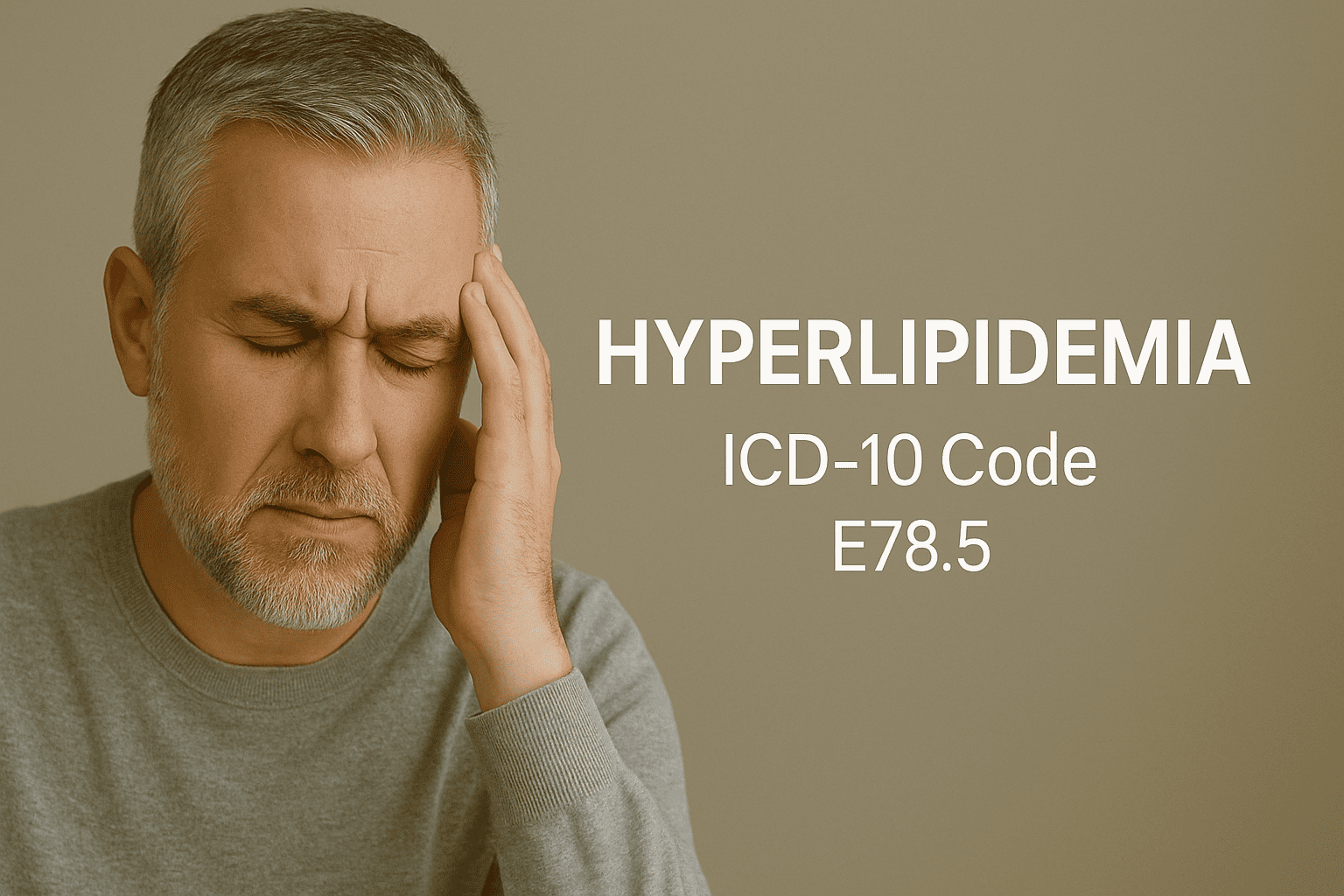Updated on: July 25, 2025
Hyperlipidemia refers to elevated levels of lipids (fats) in the blood, including cholesterol and triglycerides. It’s a major risk factor for cardiovascular disease, including heart attack and stroke. The ICD-10 code E78.5 is used when the provider diagnoses hyperlipidemia but does not specify the type—whether high LDL, high triglycerides, or mixed.
ICD-10 Code E78.5: Explained
-
E78 = Disorders of lipoprotein metabolism and other lipidemias
-
.5 = Hyperlipidemia, unspecified
Use E78.5 when:
-
Lipid abnormalities are confirmed via labs
-
No further breakdown is provided (e.g., LDL, triglycerides, HDL)
-
The patient is diagnosed with “hyperlipidemia” or “high cholesterol” with no further detail
✅ Tip: Always encourage providers to specify lipid type to allow use of more accurate E78.x codes.
Other Related ICD-10 Codes for Lipid Disorders
| ICD-10 Code | Condition |
|---|---|
| E78.0 | Pure hypercholesterolemia |
| E78.1 | Pure hyperglyceridemia |
| E78.2 | Mixed hyperlipidemia |
| E78.4 | Other hyperlipidemia |
| E78.5 | Hyperlipidemia, unspecified |
When to Use E78.5
Use E78.5 if:
-
The lipid profile is abnormal, but not detailed in the note
-
The provider does not indicate LDL vs triglyceride elevation
-
The condition is stable or under treatment without complications
Example Documentation:
“Routine lipid panel shows elevated lipids. Patient advised to begin statin therapy. Diagnosis: Hyperlipidemia (E78.5).”
When to Avoid E78.5
Avoid using E78.5 if:
-
You know the exact lipid abnormality (e.g., high LDL = E78.0)
-
The patient has familial hypercholesterolemia or other specific lipid disorders (E78.01)
-
There is a diagnosis of mixed hyperlipidemia (E78.2)
🧠 More specific coding supports better risk adjustment and care planning.
Clinical Symptoms and Risk Factors
Although often asymptomatic, hyperlipidemia increases risk of:
-
Coronary artery disease
-
Stroke
-
Peripheral vascular disease
-
Xanthomas (rare)
Risk factors include:
-
Diet high in saturated fats
-
Sedentary lifestyle
-
Diabetes and hypothyroidism
-
Genetic predisposition
Diagnostic & Management Workflow
-
Diagnosis: Confirm via lipid panel (total cholesterol, LDL, HDL, triglycerides)
-
Lifestyle counseling: Diet, exercise, weight management
-
Medication: Statins, ezetimibe, PCSK9 inhibitors
-
Monitoring: Recheck lipids every 3–6 months
-
Screening: Cardiovascular risk score, family history
Commonly Paired ICD-10 Codes
| Condition | ICD-10 Code |
|---|---|
| Essential hypertension | I10 |
| Type 2 diabetes mellitus | E11.9 |
| Obesity | E66.9 |
| Family history of cardiovascular disease | Z82.49 |
| Long-term statin use | Z79.899 |
| Tobacco use | F17.200 |
🔄 Always code comorbidities with E78.5 to reflect total cardiometabolic risk.
Documentation Tips for E78.5
To justify use of E78.5:
-
Include lab values (e.g., total cholesterol > 240 mg/dL)
-
Document intervention (diet change, statins, referral to nutritionist)
-
Specify if this is a chronic, long-term condition
-
Note treatment adherence and response
💡 Providers should be encouraged to document exact lipid findings so coders can use E78.0–E78.2 for more specificity.
Why Accurate Coding of Hyperlipidemia Matters
-
Affects clinical quality metrics (e.g., LDL control under HEDIS)
-
Impacts CMS Star Ratings and risk adjustment
-
Improves patient engagement in preventive care
-
Avoids generic coding that leads to claim downgrades
DocScrib & Hyperlipidemia Management
DocScrib, an AI-powered virtual scribe, helps practices:
-
Pull real-time lab values from EHRs
-
Recommend more specific E78.x codes during dictation
-
Capture lifestyle advice, statin use, and follow-up planning
-
Standardize templates for annual lipid review
👉 Explore how DocScrib supports preventive care documentation
Frequently Asked Questions
Can I use E78.5 with a normal lipid panel?
No. Only use E78.5 when labs confirm hyperlipidemia and the provider assigns the diagnosis.
Is E78.5 appropriate for “borderline cholesterol”?
Not always. If no formal diagnosis is made, consider R79.89 (other abnormal blood chemistry) or simply monitor without coding a disease.
Can I use E78.5 with statin therapy if the original lipid issue is unknown?
Yes, if the reason for statin is noted as lipid elevation and the type is unspecified.
Conclusion
ICD-10 Code E78.5 provides a general diagnosis for unspecified hyperlipidemia, but it’s not a substitute for detailed documentation. Providers should be encouraged to specify lipid abnormalities to support more accurate coding, care planning, and risk stratification. With tools like DocScrib, you can automate the capture of lipid management details, improving quality of care and reimbursement accuracy.
